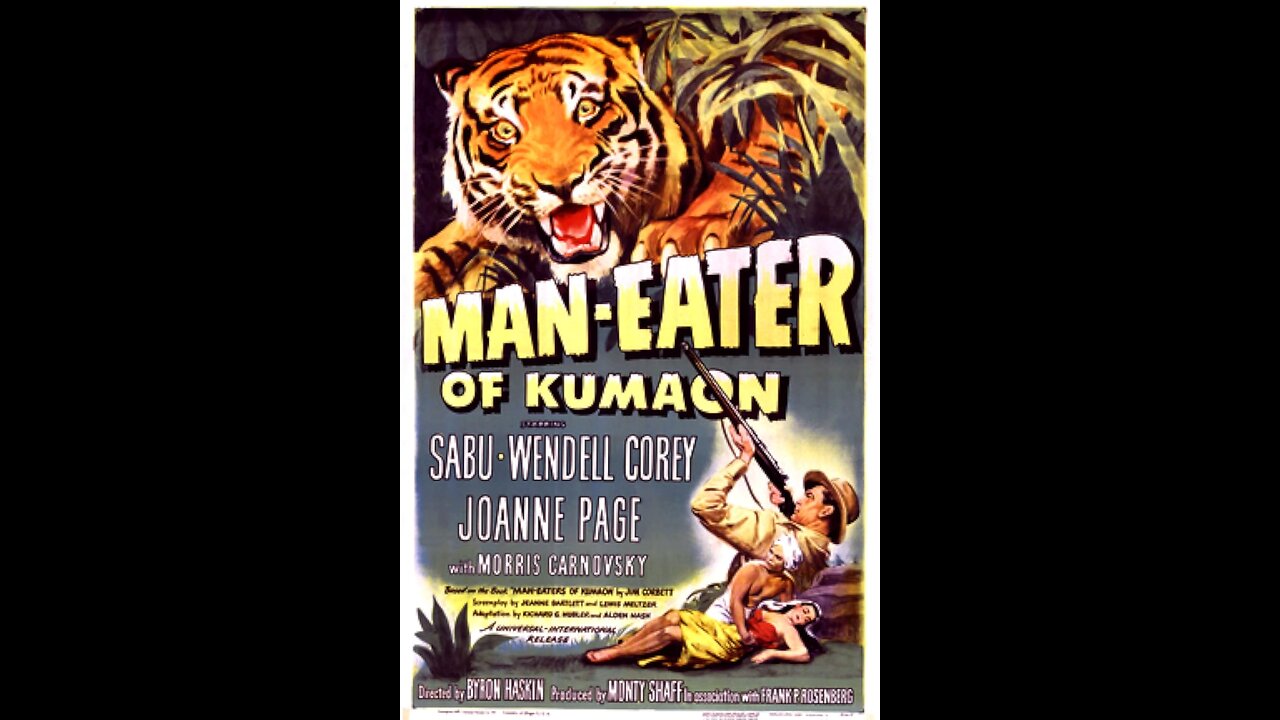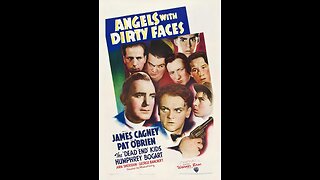Premium Only Content

Man-Eater of Kumaon (1948) | Directed by Byron Haskin
"Man-Eater of Kumaon" (1948) is an adventure film that veers into the dramatic terrain of man versus nature, specifically focusing on the hunt for a dangerous tiger in the remote Kumaon region of India. This movie, directed by Byron Haskin, is loosely based on the bestselling book of the same name by Jim Corbett, a renowned British hunter, and conservationist who later turned his attention to protecting India's wildlife. However, the film takes considerable liberties with Corbett's original accounts, incorporating fictional elements to craft a narrative suited to Hollywood's adventure genre sensibilities of the time.
The film follows Dr. John Collins (played by Wendell Corey), portrayed as a doctor rather than the hunter-conservationist Jim Corbett. Collins becomes embroiled in the pursuit of a notorious man-eating tiger, which has been terrorizing the local villages in the Kumaon region. As the tiger's attacks increase, Collins, initially reluctant, is drawn deeper into the conflict with the beast, exploring themes of courage, respect for nature, and the ethical dilemmas faced by those who seek to intervene in the natural order.
"Man-Eater of Kumaon" attempts to blend the adventure genre with a thoughtful examination of the human impact on wildlife, though with mixed results. Wendell Corey, in one of his earlier leading roles, delivers a solid performance as Dr. Collins, capturing the internal conflict of a man torn between his duties as a healer and the pressure to confront the tiger. The film's cinematography, capturing the lush landscapes and the tense, shadowy encounters with the tiger, adds a level of suspense and visual appeal.
However, the film's portrayal of Indian culture and characters falls into stereotypical representations, common in Hollywood's depictions of non-Western settings at the time. This aspect has not aged well and detracts from the movie's attempt to convey a respect for nature and the complexities of human-animal conflict.
The film's biggest criticism lies in its departure from the true spirit and factual accounts of Jim Corbett's experiences, which were marked by a deep reverence for India's wildlife and an early call for conservation efforts. Instead, the movie leans towards a more sensationalized and fictionalized narrative, prioritizing drama and action over authenticity and the ethical contemplation found in Corbett's writings.
Additionally, the film's simplistic and sometimes patronizing portrayal of local Indian characters and culture reflects the era's limited understanding and respect for cultural complexities, a factor that modern audiences might find problematic or offensive.
Released on November 7, 1948, and directed by Byron Haskin, "Man-Eater of Kumaon" stars Wendell Corey in a role that diverges significantly from the real-life figure of Jim Corbett on whom the character is based. While the film offers moments of suspense and adventure against the backdrop of India's stunning natural scenery, it falls short in capturing the true essence of Corbett's conservationist legacy and presents a missed opportunity to explore more deeply the themes of human coexistence with nature. Despite its attempt to engage with these themes, the film is a product of its time, both in terms of cinematic style and cultural sensitivity, which may affect its reception by contemporary audiences.
The cast of "Man-Eater of Kumaon" (1948) includes:
Wendell Corey as Dr. John Collins, the central character drawn into the hunt for a man-eating tiger. This role is a departure from the real Jim Corbett, on whom the character is loosely based.
Joy Page plays Ganga Ram, a key local figure who interacts closely with Dr. Collins. Her character is pivotal in bridging the cultural and emotional gaps between the local community and the protagonist.
Sabu portrays Narain, a young and brave local who becomes involved in the efforts to track down the tiger. Sabu, a well-known actor for his roles in adventure films, adds an element of authenticity and depth to the portrayal of Indian characters, though the film overall does not escape the era's stereotypical depictions.
Morris Carnovsky features as the Pundit, a wise and respected elder in the village, offering guidance and insight as the community grapples with the threat of the tiger.
Joseph Calleia plays a significant role as another villager involved in the conflict with the tiger. His character adds to the film's exploration of the varied reactions within the community to the tiger's menace.
-
 1:37:17
1:37:17
Classic Films & Movies Archive
9 days agoAngels with Dirty Faces (1938) | Directed by Michael Curtiz
262 -
 DVR
DVR
VSiNLive
1 hour agoA Numbers Game with Gill Alexander | Hour 1
9 -
 LIVE
LIVE
The Big Mig™
3 hours agoAct Blue, Magic Mortgage Money Laundering Scheme
5,146 watching -
 2:03:57
2:03:57
Matt Kohrs
10 hours agoMARKET OPEN: Stocks Rocket, Trade War News & Earnings Season || Live Trading
11.6K2 -
 1:25:02
1:25:02
Dear America
3 hours agoHere’s EVERYTHING We Know About The “White” NYC Shooter… + Trump Secures MAJOR Deal With EU!!
112K94 -
 LIVE
LIVE
Badlands Media
4 hours agoBadlands Daily: July 29, 2025
3,914 watching -
 1:01:27
1:01:27
Part Of The Problem
12 hours agoDave Smith | The System is Broken | Part Of The Problem 1290
6.09K10 -
 LIVE
LIVE
Wendy Bell Radio
6 hours agoWhen Are "The Experts" Ever Right?
7,496 watching -
 1:07:01
1:07:01
The Mike Schwartz Show
2 hours agoTHE MIKE SCHWARTZ SHOW with DR. MICHAEL J SCHWARTZ 07-29-2025
6.08K1 -
 1:09:29
1:09:29
Dialogue works
14 hours ago $0.34 earnedLarry C. Johnson & Pepe Escobar: Trump's Pressure Backfires, Russia Ignites Unstoppable BRICS Unity
8.51K8